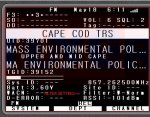Before I start, I'd like to say the manual that comes with the SDS100/200 is the weakest POS I've ever seen. In a radio with so many advanced settings, one would think the manufacturer would at least put together a PDF manual that explains the basics of what they do and examples of when to use them, so that you have at least an idea what settings do before you use them (rather than the time consuming trial-and-error method we're stuck with).
I've been a ham for 40 years and and public safety communications professional nearly that long. I'm not an RF neophyte; I've built and serviced radios and repeaters, tuned filters and duplexers and have reasonably good knowledge of how they work. If the manual gave a clue I could probably figure it out, but there's nothing; pretty bad for a $700 radio.
Soooo, I've been tinkering around with settings in my SDS100 and 200 and have some questions related to the filters. Going through the menu, I see the following filters listed; they're followed by my questions (making the assumption that we're talking about bandpass filters).
Global - Obviously affects the entire radio, but what does the passband look like?
Normal - Normal in relation to what? Again, what does the passband look like?
Invert - What does the passband look like? What are we inverting? Flipping the filter skirts around 180 degrees?
Auto - Assuming this means it selects the best filter for the situation, but how does it determine that?
Wide XXXX - I'm assuming the Wide settings are all the same as the above but with a wider bandpass.
What is the bandwidth/passband of the Normal setting versus the Wide setting? Even an approximate idea would be helpful.
What does the passband look like? Narrow at the frequency of interest then broadening out to the sides? Broad on one side and narrow on the other side? Or is it a pretty narrow passband on both sides covering only the frequency of interest? Being software defined there's all kinds of neat stuff they can do.
And we've got IFX - IF eXchange. . . but what's being exchanged? I'm assuming it's being shifted from low-side injection to high-side.
These are all things that should have been covered in the manual, but weren't. Mark's Easier to Read manual is a great leap ahead of the POS from Uniden, but his section on Filters is still blank and the section on IFX is pretty basic (although enough to give me a clue as to what might be going on).
Figuring some of you all have been tinkering deeply longer than I have, so someone might have a bit of insight.
Thanks,
Tom
I've been a ham for 40 years and and public safety communications professional nearly that long. I'm not an RF neophyte; I've built and serviced radios and repeaters, tuned filters and duplexers and have reasonably good knowledge of how they work. If the manual gave a clue I could probably figure it out, but there's nothing; pretty bad for a $700 radio.
Soooo, I've been tinkering around with settings in my SDS100 and 200 and have some questions related to the filters. Going through the menu, I see the following filters listed; they're followed by my questions (making the assumption that we're talking about bandpass filters).
Global - Obviously affects the entire radio, but what does the passband look like?
Normal - Normal in relation to what? Again, what does the passband look like?
Invert - What does the passband look like? What are we inverting? Flipping the filter skirts around 180 degrees?
Auto - Assuming this means it selects the best filter for the situation, but how does it determine that?
Wide XXXX - I'm assuming the Wide settings are all the same as the above but with a wider bandpass.
What is the bandwidth/passband of the Normal setting versus the Wide setting? Even an approximate idea would be helpful.
What does the passband look like? Narrow at the frequency of interest then broadening out to the sides? Broad on one side and narrow on the other side? Or is it a pretty narrow passband on both sides covering only the frequency of interest? Being software defined there's all kinds of neat stuff they can do.
And we've got IFX - IF eXchange. . . but what's being exchanged? I'm assuming it's being shifted from low-side injection to high-side.
These are all things that should have been covered in the manual, but weren't. Mark's Easier to Read manual is a great leap ahead of the POS from Uniden, but his section on Filters is still blank and the section on IFX is pretty basic (although enough to give me a clue as to what might be going on).
Figuring some of you all have been tinkering deeply longer than I have, so someone might have a bit of insight.
Thanks,
Tom
Last edited:



